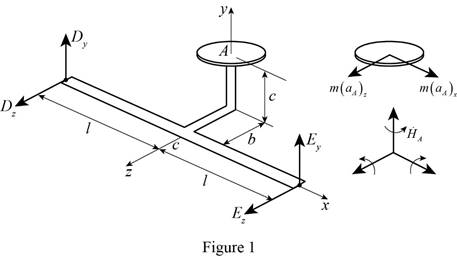
Concept explainers
The dynamic reaction at D (D) and E (E).
Answer to Problem 18.153RP
The dynamic reaction at D (D) and E (E) are
Explanation of Solution
Given Information:
The weight of the disk (W) is 6 lb.
The constant angular velocity
The constant angular velocity
The radius (r) of the disk is
The length (l) of the rod is
The length of the rod from disk to point B (b) and B to C (c) is
Assume the acceleration due to gravity (g) as
Calculation:
Write the expression for the angular velocity
Write the expression for the angular velocity
Write the expression the centroidal moment of inertia
Write the expression the centroidal moment of inertia
Write the express the angular moment
Substitute
Let the reference frame Oxyz be rotating with angular velocity
Write the express the angular momentum
Substitute
Write the express the rate of change of angular
Substitute
Write the expression for the position vector
Write the expression for the velocity
Substitute
Write the expression for the acceleration
Substitute
Show the impulse momentum diagram as in Figure (1).

Write the expression for the sum of the forces:
Substitute
Resolve the i and k component,
Express the moment about the point D.
Write the expression for the position vector
Write the expression for the sum of the moment about D:
Substitute
Resolve the component i, j and k component.
For i component,
For j component,
For k component,
Calculate the mass of the disk (m) using the relation:
Substitute 6lb for W and
Differentiate the angular velocity of
Differentiate the angular velocity of
Calculate the z component dynamic reaction
Substitute  ,
,
Calculate the y component dynamic reaction
Substitute
Calculate the y component dynamic reaction
Substitute
Calculate the z component dynamic reaction
Substitute
Calculate the dynamic reaction (D) at D:
Substitute
Calculate the dynamic reaction (E) at E:
Substitute
Thus, the dynamic reaction at D (D) and E (E) are
Want to see more full solutions like this?
Chapter 18 Solutions
VEC MECH 180-DAT EBOOK ACCESS(STAT+DYNA)
 Elements Of ElectromagneticsMechanical EngineeringISBN:9780190698614Author:Sadiku, Matthew N. O.Publisher:Oxford University Press
Elements Of ElectromagneticsMechanical EngineeringISBN:9780190698614Author:Sadiku, Matthew N. O.Publisher:Oxford University Press Mechanics of Materials (10th Edition)Mechanical EngineeringISBN:9780134319650Author:Russell C. HibbelerPublisher:PEARSON
Mechanics of Materials (10th Edition)Mechanical EngineeringISBN:9780134319650Author:Russell C. HibbelerPublisher:PEARSON Thermodynamics: An Engineering ApproachMechanical EngineeringISBN:9781259822674Author:Yunus A. Cengel Dr., Michael A. BolesPublisher:McGraw-Hill Education
Thermodynamics: An Engineering ApproachMechanical EngineeringISBN:9781259822674Author:Yunus A. Cengel Dr., Michael A. BolesPublisher:McGraw-Hill Education Control Systems EngineeringMechanical EngineeringISBN:9781118170519Author:Norman S. NisePublisher:WILEY
Control Systems EngineeringMechanical EngineeringISBN:9781118170519Author:Norman S. NisePublisher:WILEY Mechanics of Materials (MindTap Course List)Mechanical EngineeringISBN:9781337093347Author:Barry J. Goodno, James M. GerePublisher:Cengage Learning
Mechanics of Materials (MindTap Course List)Mechanical EngineeringISBN:9781337093347Author:Barry J. Goodno, James M. GerePublisher:Cengage Learning Engineering Mechanics: StaticsMechanical EngineeringISBN:9781118807330Author:James L. Meriam, L. G. Kraige, J. N. BoltonPublisher:WILEY
Engineering Mechanics: StaticsMechanical EngineeringISBN:9781118807330Author:James L. Meriam, L. G. Kraige, J. N. BoltonPublisher:WILEY





